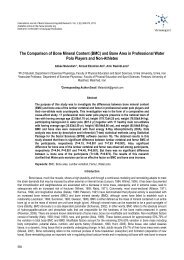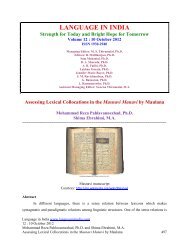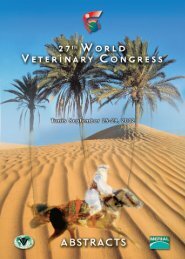Improved DAG SVM: A New Method for Multi-Class SVM Classification
Improved DAG SVM: A New Method for Multi-Class SVM Classification
Improved DAG SVM: A New Method for Multi-Class SVM Classification
You also want an ePaper? Increase the reach of your titles
YUMPU automatically turns print PDFs into web optimized ePapers that Google loves.
Int'l Conf. Artificial Intelligence | ICAI'09 | 551<br />
(b)<br />
(a)<br />
Figure 5: General overview of the proposed W<strong>DAG</strong> <strong>SVM</strong><br />
scheme, (a) training module and (b) testing module.<br />
Description of Testing Module<br />
Testing module includes basic levels such as weighing<br />
procedure (WP), decision making, and voting which are<br />
shown in Figure 5.b and discussed separately as follows:<br />
Level 1: Weighting Procedure (WP)<br />
In this level, the membership degree of each testing data<br />
to each cluster is calculated using Gaussian distribution<br />
functions which have been achieved in the previous section.<br />
Let �� � �<br />
����� �� �be a set of -dimensional test samples.<br />
Membership degree of �� in relation to Mth cluster<br />
�� � ���� � � �� according to (12) is given as:<br />
� � � �<br />
�<br />
�������<br />
������� � ����� �� �� � ������������������<br />
Note that the output of the weighting procedure is � �<br />
where M=1,..,N and N is the number of clusters.<br />
Level 2: Decision Making<br />
The label of � � (where � � is a test data) is calculated using<br />
majority-based decision obtained from <strong>DAG</strong> <strong>SVM</strong> which is<br />
trained <strong>for</strong> the M th cluster.<br />
Let the decision function <strong>for</strong> class i against class j, <strong>for</strong> the<br />
M th cluster with the maximal margin, be:<br />
� �� � ���� �� �� � ���� �� ��������������������������������<br />
and in each cluster we follow the corresponding <strong>DAG</strong> <strong>SVM</strong><br />
structure <strong>for</strong> determining class label of � �. At the end of this<br />
stage, each cluster returns a local class label � � (i=1, ..., N),<br />
where N is the number of clusters. Voting is the final stage<br />
that determines the global class label of � � considering<br />
clusters judgment and membership degrees.<br />
Level 3: Voting<br />
Output of this level is achieved by the fusion operation.<br />
The combining procedure can improve classification rate.<br />
Suppose that � ��� ��� ����� �� is set of labels <strong>for</strong> a given<br />
test sample � � that are determined by N <strong>DAG</strong> <strong>SVM</strong>, also<br />
���� ��� ����� �� is set of membership degrees of a<br />
same test sample � � to each cluster, where N is the number<br />
of clusters. Finally, output is achieved by:<br />
where<br />
and<br />
����������� � ��� �������������������������������� ������<br />
�� ��������������������������������������������� ��� ��<br />
� � � ���� � � ������ � � �� � � �������������������������<br />
where n is the number of classes. � � is set of labels which<br />
mention to class i and � � is sum of their weights. Equation<br />
(15) demonstrate that � � is assigned to a class with<br />
maximum � �. In the other words, two following points are<br />
required to classification of input samples:<br />
� Number of labels assigned to each class<br />
� Weight (degree of importance that is achieved<br />
from WP) of each classifier that participates in<br />
voting procedure.<br />
There<strong>for</strong>e, if a class is mentioned with a large number of<br />
<strong>DAG</strong> <strong>SVM</strong> and also weights of these classifiers be high<br />
enough, then the test sample is assigned to it.<br />
5 Experimental Evaluation<br />
The proposed method has been evaluated over a series of<br />
synthetic data. In Table 1, the accuracy of <strong>DAG</strong> <strong>SVM</strong> and<br />
W<strong>DAG</strong> <strong>SVM</strong> classifiers <strong>for</strong> a series of synthetic data has<br />
been compared. The number of synthetic data is 150 (50<br />
data in each class). Four types of data are considered. In<br />
data type 1, separate data is used and gradually in data set 2<br />
to 4 classes are interlaced (shown in Figure 6). As shown in<br />
Table 1, comparing the two methods, W<strong>DAG</strong> <strong>SVM</strong> gives<br />
better results in each level of interlacing.








